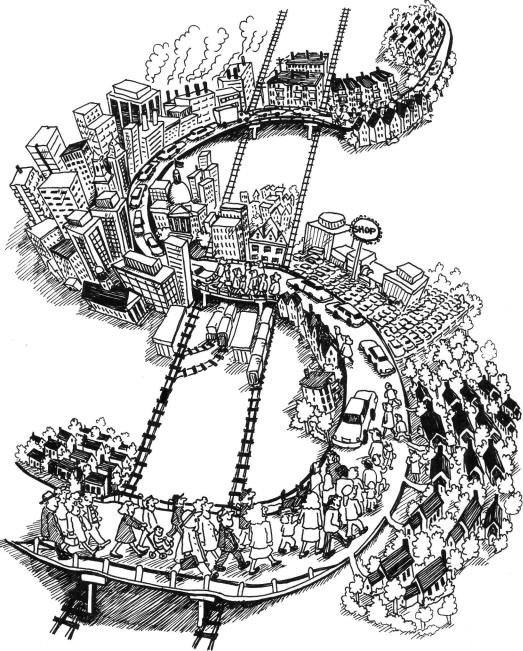
contactusa
.pdf
Ε. Word Analysis
Part 1
DIRECTIONS: Are the italicized words used as nouns or as adjectives?
NOUN ADJECTIVE
1.Salt is an ingredient used in cooking.
2.That is quite a wealthy neighborhood.
3.What is your problem?
4.He is a native of the United States.
5.My native language is English.
6.There is a large group of people outside.
7.What's the difference?
8.This is your book, isn't it?
9.What color is your hair?
10. My eyes are brown.
Part 2
la. These prefixes change the meaning of a word from positive to negative: Another example:
un- |
willing |
unwilling |
|
|||
in- |
formal |
informal |
|
|||
im- |
possible |
impossible |
|
|||
dis- |
agree |
disagree |
|
|||
lb. Study the meanings of these:
heterodifferent |
heterogeneous |
|
|
homosame |
homogeneous |
|
|
The population in the United States is heterogeneous. In Japan, the population is more homogeneous.
2. Complete the sentences with one of the words from la or lb.
a. Our class is a(n) |
|
group. We have students from many |
different countries. |
|
|
Contact a Point of View 29
b. |
Slaves were |
|
|
immigrants to the United States. |
|||||
|
|
|
|
|
|
|
|
|
|
с |
Our ideas are completely different. I |
|
|
|
with you. |
||||
d. I can't do that. I'm sorry, but it's |
|
|
|
|
|
|
|||
e. I have a(n) |
|
lifestyle, so I don't have very many dressy |
|||||||
|
|
|
|
||||||
|
clothes. I usually wear pants and a sweater. |
||||||||
f.In that new neighborhood, the people are all similar—they all have about the same income and are about the same age. They even drive the same kinds of
cars. It's too |
for me! |
|
|
|
|
30 A Country of Immigrants

section 4
Look Back
A. Vocabulary
DIRECTIONS: Circle the letter of the choice that best completes each sentence.
1. Chicken and noodles are two |
|
|
in chicken noodle soup. |
||
a. mixtures |
b. |
divisions |
с ingredients |
||
2.A group of people with many different religions, languages, and races is a____
group.
a. racial b. cultural с mixed 3. He is a complete stranger to me. I don't know anything about his
a. concept b. background с assistance
4., the party will begin at 8:00 P.M., but I don't believe it.
|
a. Typically |
|
|
|
b. Supposedly |
с |
Positively |
|||||||
5. A class is a |
of students. |
|
|
|
|
|||||||||
|
a. group |
|
|
|
|
|
|
b. neighborhood |
с |
reflection |
||||
6. |
I want to buy the apartment building. Then I will be the |
|
|
|
||||||||||
|
a. neighbor |
|
|
|
b. assistant |
с |
owner |
|||||||
7. |
I came to this |
|
|
because I wanted to live in a different area. |
||||||||||
|
a. place |
|
|
|
|
|
|
b. mixture |
с |
division |
||||
8. |
He |
|
lives here. He moved out of town last month. |
|
|
|||||||||
|
a. no longer |
|
|
|
b. supposedly |
с |
permanently |
|||||||
9. |
She is a very |
|
|
person. She goes to church twice a week. |
||||||||||
|
a. unwilling |
|
|
|
|
b. political |
с |
religious |
||||||
10. |
I like everything about my apartment |
|
the cost. It is too expensive. |
|||||||||||
|
a. with |
|
|
|
|
|
|
b. except for |
с |
entirely |
||||
31
В. Matching
DIRECTIONS: Find the word or phrase in column В which has a similar mean ing to a word or phrase in column A. Write the letter of that word or phrase next to the word or phrase in column A.
|
А |
|
В |
1. |
opportunity |
a. an area of a town or city |
|
2. |
varied |
b. have together |
|
3. |
except for |
с |
chance |
4. |
entirely |
d. |
try to find |
5. |
such as |
e. name |
|
6. |
look for |
f. |
all |
7. |
neighborhood |
g. |
but |
8. |
recent |
h. |
for example |
9. |
call |
i. |
close to the present |
10. |
share |
j. |
diverse |
C.Synthesis Questions
1.Interview other people (a classmate, your teacher, people on the street). Ask them about their background: where they were born; where their families were from; etc. . . . Work with your classmates to write in terview questions.
2.Do you see examples of different kinds of people (religions, races, in come level) living and working together in the United States or do you see examples of people staying apart because of these differences?
3.Find out more about native Americans. Go to the library or a museum and do research on this topic.
D.Vocabulary Preview
DIRECTIONS: What shorter words can you see in these words from Chapter 3?
employment |
(1) |
employ |
unlike |
(3) |
|
movement |
(2) |
|
revitalize |
(4) |
|
|
|
|
|
|
|
32 A Country of Immigrants
countless |
(5) |
_____________ |
reconstruction |
(9) |
|
|
|
improvement |
|
(6) |
|
rebuild |
(10) |
|
|
entertainment |
|
(7)___________ |
government |
(11) |
|
|
|
apartment |
(8) |
|
|
alive |
(12) |
|
|
Look Back |
33 |

chapter 3
Cities in America

section 1
A First Look
A. Background Building
1.Where do you come from? From a city? From the suburbs (just outside the city) or from the country (far from a city)?
2.This chapter is about cities in America, but cities everywhere are similar. Write some impressions you have when you think about cities.
3.Which of your impressions are positive? Which are negative? Neutral?
B. Topic
DIRECTIONS: Before you begin to read, look at these topics. There is one topic for each paragraph. Look guickly at the reading to find these topics. Do not read every word at this point. Write the number of the paragraph next to the topic of that paragraph.
1.population information
2.cities are living again
3.where people are moving now
4.a description of cities
5.a house in the suburbs
6.a new type of city resident
7.results of the move back to the cities
C. Reading
DIRECTIONS: Now read.
35

American cities are similar to other cities around the world: |
1 |
|
In every country, cities reflect the values of the culture. Cities con- |
2 |
|
tain the very best aspects of a society: opportunities for education, |
3 |
|
employment, and entertainment. They also contain the very worst |
4 |
|
parts of a society: violent crime, racial conflict, and poverty. Amer- |
5 |
|
ican cities are changing, just as American society is changing. |
6 |
|
After World War II, the population of most large American |
7 |
|
cities decreased; however, the population in many Sun Belt cities |
8 |
|
(those of the South and West) increased. Los Angeles and Houston |
9 |
|
are cities where population increased. These population shifts (the |
10 |
|
movement of people) to and from the city reflect the changing val- |
11 |
|
ues of American society. |
12 |
|
During this time, in the late 1940s and early 1950s, city resi- |
13 |
|
dents became wealthier, more prosperous. They had more children |
14 |
|
so they needed more space. They* moved out of their apartments in |
15 |
|
the city to buy their own homes. They bought houses in the sub- |
16 |
|
urbs (areas without many offices or factories near cities). During |
17 |
|
the 1950s the American "dream" was to have a house in the |
18 |
|
suburbs. |
19 |
|
Now things are changing. The children of the people who left |
20 |
|
the cities in the 1950s are now adults. They, unlike their parents, |
21 |
|
want to live in the cities. Some continue to move to cities in the Sun |
22 |
|
Belt. Cities are expanding and the population is increasing in such |
23 |
|
states as Texas, Florida, and California. Others are moving to older, |
24 |
|
more established cities of the Northeast and Midwest, such as Bos- |
25 |
|
ton, Baltimore and Chicago. The government, industry, and indi- |
26 |
|
viduals are restoring old buildings, revitalizing poor neighborhoods, |
27 |
|
and rebuilding forgotten areas of these cities. |
28 |
|
Many young professionals, doctors, lawyers, and executives, |
29 |
|
are moving back into the city. Many are single; others are married, |
30 |
|
but often without children. They prefer the city to the suburbs be- |
31 |
|
cause their jobs are there; or they just enjoy the excitement and |
32 |
|
opportunities that the city offers. A new class is moving into the |
33 |
|
cities—a wealthier, more mobile class. |
34 |
|
This population shift is bringing problems as well as benefits. |
35 |
|
Countless poor people must leave their apartments in tfie^city be- |
36 |
|
cause the owners want to sell the buildings or make condominiums, |
37 |
|
apartments which people buy instead of rent. In the 1950s, many |
38 |
|
poor people did not have enough money to move to the suburbs; |
39 |
|
now many of these same people do not have enough money to stay |
40 |
|
in the cities. |
41 |
|
Only a few years ago, people thought that the older American |
42 |
|
cities were dying. Some city residents now see a bright, new future. |
43 |
|
Others see only problems and conflicts. One thing is sure: many |
44 |
|
dying cities are alive again. |
45 |
|
Cities in America

React
In the reading choose one sentence that you find interesting and write it here. Talk about its meaning with a partner.
D. Scanning/Vocabulary
Part 1
DIRECTIONS: Write the line number where you find the wordfsj. Then choose the best meaning for the word as it is used in that sentence.
Part 2
DIRECTIONS: Find a word that is the opposite of the one given. The line where you will find the word is given.
A First Look |
37 |

1. |
line 4 |
best |
2. |
line 5 |
wealth |
3. |
line 8 |
increased |
4. |
line 14 |
poorer |
5. |
line 19 |
city |
6. |
line 21 |
similar to |
7. |
line 23 |
growing smaller |
8. |
line 27 |
destroying |
9. |
line 32 |
boredom |
10. |
line 45 |
alive |
E. Reading Comprehension
DIRECTIONS: Circle the letter of the choice that best completes each sentence.
1. The author thinks that cities all over the world are |
|
|
a. the same |
b. similar |
с different |
2. In paragraph 1, the author says that some good aspects of cities are schools,
|
|
, and things to do. |
|
|
|
|
|
|
|||||
|
a. values |
|
b. jobs |
|
|
|
с |
changes |
|||||
3. The author gives |
|
examples of the worst parts of a culture. |
|||||||||||
|
a. two |
|
|
b. three |
|
|
|
с |
four |
||||
4. The population of most large American cities |
|
after World War II. |
|||||||||||
|
a. decreased |
|
b. increased |
|
|
|
|
с |
remained the same |
||||
5. The population in Houston and Los Angeles, |
|
the population in most other |
|||||||||||
|
cities, increased after the war. |
|
|
|
|
|
|
|
|||||
|
a. similar to |
|
b. unlike |
|
|
|
с |
as well as |
|||||
6. City residents became wealthier and more prosperous |
|
World War II. |
|||||||||||
|
|
|
|
|
|
|
|
|
|
|
|||
|
a. during |
|
b. after_j |
|
|
|
с |
before |
|||||
7. In the 1950s many city residents wanted to |
|
|
|
|
|
|
|
||||||
|
a. live in the suburbs |
|
b. revitalize the city |
|
|
|
с |
live in |
|||||
|
|
|
|
|
|
|
|
|
|
|
|
apartments |
|
38 Cities in America
